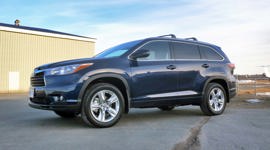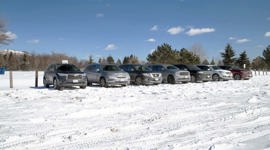 AutoTrader SCORE
AutoTrader SCORE
-
STYLING8/10
-
Safety9/10
-
PRACTICALITY8/10
-
USER-FRIENDLINESS7/10
-
FEATURES8/10
-
POWER9/10
-
COMFORT8/10
-
DRIVING FEEL8/10
-
FUEL ECONOMY8/10
-
VALUE8/10
There’s a lot of good competition in the three-row SUV segment, but this is one of the most popular ones: the 2022 Toyota Highlander.
Most of the changes for 2022 are minimal trim upgrades, since the Highlander was redesigned for 2020, but a major point is that all trim levels now come standard with all-wheel drive (AWD).
The Highlander is available as a hybrid, but I had the gasoline-only version, which starts at $46,640 including a non-negotiable delivery charge of $1,890 but before taxes. My tester was the top-of-the-line Limited, starting at $55,080 and then optioned to $57,635 with a Platinum package of features and a coat of extra-charge red paint.
Styling: 8/10
The Highlander’s styling is more sleek sport-ute than people-mover. The nose is a bit bulbous, but tied together well with the winged badge; and in profile, the side windows curve to a handsome point without reducing too much visibility – although I’m not a fan of the exaggerated muscle that rises across the doors and over the rear wheels, which looks like overdone cladding. The two lower trims get 18-inch wheels, while the XSE and Limited get 20-inch alloys, which look good but cost more for replacement tires.
Inside, the Highlander’s styling is a bit busy, but I like the multiple levels of the dash, which incorporate two open cubbies, one in the centre stack and the other in front of the passenger, that are handy for stashing items like gloves. The controls and centre stack are surrounded by a shiny black bezel and, as I’ll get to shortly, it creates a bit of an issue.
Safety: 9.5/10
The Highlander gets the top five-star rating from the United States National Highway Traffic Safety Administration (NHTSA), as well as Top Safety Pick+ from the Insurance Institute for Highway Safety (IIHS).
Toyota puts almost all of its driver-assist safety technologies on all trim levels, including emergency front braking with pedestrian and cyclist detection, adaptive cruise control, lane-departure assist, blind-spot monitoring, rear cross-traffic alert, and automatic high-beam headlights. The exceptions are an anti-theft system, on the XLE and up, and cross-traffic rear braking on the Limited. All trims include a rearview camera, mandatory on all new passenger vehicles sold in Canada.
Features: 8/10
The base LE trim comes with a number of standard features, including dual-zone automatic climate control, heated front seats, automatic headlights, and Apple CarPlay and Android Auto. The next-step-up XLE adds items including a sunroof, tri-zone climate, heated steering wheel, and power tailgate. By the time you get to my Limited, you also get wireless charging, navigation, leather upholstery, ventilated front seats, hands-free tailgate, and panoramic sunroof.
My tester included a $2,300 Platinum package, available only on the Limited. It includes a 12.3-inch centre touchscreen, head-up display, bird’s-eye-view camera, digital rearview mirror, heated second-row seats, reverse tip-down mirrors, and rain-sensing wipers.
User Friendliness: 7/10
It’s easy to get in and out of the Highlander, at least in the first two rows. As with most three-row SUVs, squeezing into the third row is best done by children and very flexible adults. The tailgate’s wide opening and low liftover help with loading cargo in as well.
But I’ve deducted points for my tester’s controls, which are a mix of good and not-so. You get dials for the stereo volume and tuning, which is good, but toggles for temperature and fan speed, which take a little more attention; and if you want to change the climate mode, it’s a small icon in the centre screen. That big screen displays up to three functions, and has a swipe feature to switch between them. But it’s glossy glass surrounded by a glossy black bezel, and any time the sun hits it, the glare washes it out. If important functions are in a screen, it’s equally important that the driver be able to see them.
Practicality: 8/10
As with most in this three-row category, passenger space is roomy in the first and second rows, and very tight in the third. The two lower trim levels hold eight passengers, while upper trims accommodate seven, swapping the second-row bench for two captain’s chairs.
Small-item storage is good, with big door pockets and a front cubby, and the wireless charger is inside the centre console box, where it hides your phone and frees up more console storage. Rear cargo space is naturally limited with the third row up, but that’s sometimes a benefit; when I grabbed some groceries, that upright third row kept them from sliding around. Both rear rows fold flat for longer cargo. If you need to carry more, the Highlander is rated for a maximum towing capacity of 2,268 kg (5,000 lb).
Comfort: 8/10
The first-row seats are very comfortable and supportive; the second row will keep passengers happy even on longer drives; and the flat, rock-hard third row is pretty much for short-haul trips. The Highlander also offers a smooth ride and a quiet cabin.
Power: 9/10
The Highlander uses a 3.5L V6 that makes 295 hp and 263 lb-ft of torque, mated to an eight-speed automatic transmission. It’s a very good engine, with smooth acceleration and lots of passing power on the highway. I especially like that it isn’t turbocharged. I prefer the simplicity of a non-turbo engine, especially if the plan is to keep the vehicle for a long time.
The standard AWD system runs primarily in front-wheel drive, but constantly monitors conditions, and automatically sends power to the rear wheels as needed. On the XSE and Limited, a torque vectoring system can then distribute power between the right and left rear wheels to further improve traction. These trims also include a rear-wheel disconnect that improves fuel economy, but hooks up the rear wheels immediately when more traction is required.
Driving Feel: 8/10
While the Highlander’s lane-departure assist literally helps prevent you from driving in the middle of the road, that’s where this vehicle’s driving feel figuratively sits. That said, that’s not a crack at it; this is a people-mover, not a sports car, and it behaves as you’d expect a family commuter vehicle to be.
It’s very well-mannered; the steering isn’t lively, but it’s smooth and accurate. It’s well-collected around corners, without much body roll, and the brake pedal has confident feel and brings the Highlander to a smooth stop. The turning circle is also much tighter than I expected, which helps with tight parking spots.
Fuel Economy: 8.5/10
The Highlander is rated by Natural Resources Canada (NRCan) at 11.8 L/100 km in the city, 8.6 on the highway, and 10.3 in combined driving. In my week with it in bitterly cold weather, I came in higher at 12.2 L/100 km. Regular-grade gas is all that’s required.
Those official ratings are below those of some of its primary competitors in combined driving, although some by a fraction. Mazda’s CX-9 comes in at 10.4, and the Nissan Pathfinder at 10.5. The Honda Pilot rates at 11.0; the Kia Telluride at 11.3; and the Volkswagen Atlas comes in at 11.7 L/100 km. If you opt for the Highlander Hybrid, it rates a mere 6.7 L/100 in combined driving.
Value: 8/10
With destination charge, the Highlander retails between $46,640 and $55,080, and $57,380 if you add the Platinum package. That’s about midway between some of its prime competitors. The Mazda CX-9 starts at $43,031; and the Nissan Pathfinder runs between $46,488 and $56,948, all prices with destination.
The Volkswagen Atlas starts at $43,732 but tops out at $59,832; and the Kia Telluride ranges from $48,890 to $58,590. None are inexpensive, but the Toyota holds its own among them.
The Verdict
The Highlander outsold its three-row competitors in 2021, often by a wide margin. A couple areas inside could be better, but overall, this is a comfortable, well-equipped, and smooth-driving vehicle that’s intelligently priced. Give it a test-drive if you’re in the market for this size of people-mover.
| Engine Displacement | 3.5L |
|---|---|
| Engine Cylinders | V6 |
| Peak Horsepower | 295 hp @ 6,600 rpm |
| Peak Torque | 263 lb-ft @ 4,700 rpm |
| Fuel Economy | 11.8 / 8.6 / 10.3 L/100 km cty/hwy/cmb |
| Cargo Space | 453 / 1,370 / 2,387 L behind 3rd/2nd/1st row |
| Model Tested | 2022 Toyota Highlander Limited Platinum |
| Base Price | $53,190 |
| A/C Tax | $100 |
| Destination Fee | $1,890 |
| Price as Tested | $57,735 |
|
Optional Equipment
$2,555 – Platinum Package, $2,300; Ruby Flare Pearl paint, $255
|
|
























































